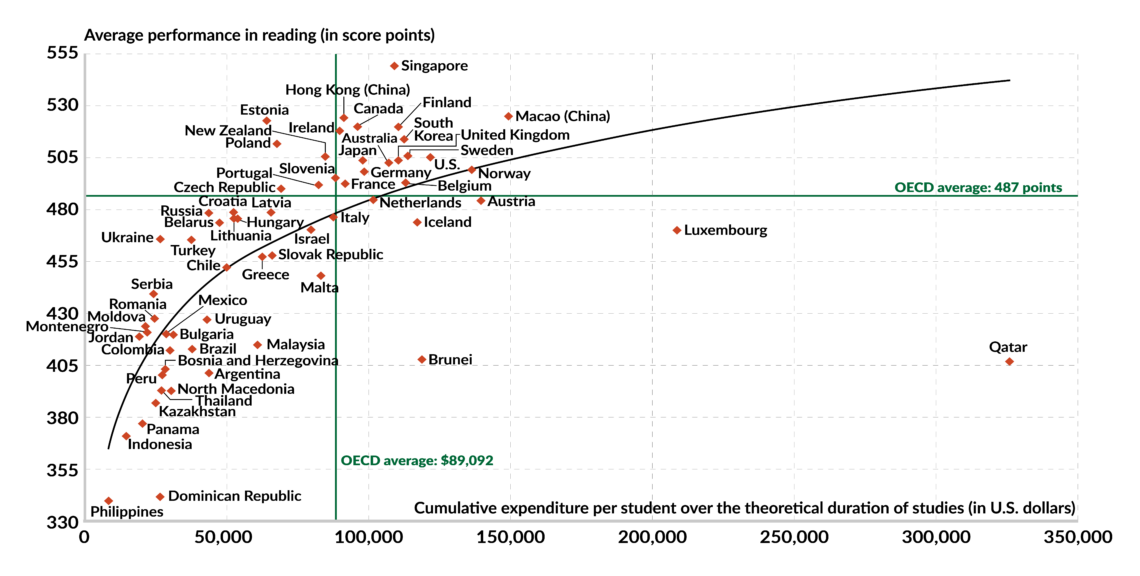Learning the lessons of wasteful education spending
The OECD’s recent education scores underline how poorly schools are educating today’s youth. The results will probably spur calls for more education spending. However, keeping students in school longer may not give them better opportunities in the job market.

In a nutshell
- Increased education spending has not improved outcomes
- Continuing to poorly educate people will increase inequality
- Privatization could improve schools and workers’ ambition
Recently, the Organisation for Economic Co-operation and Development (OECD) published the results of the 2018 Programme for International Student Assessment (PISA). The considerable set of data, tables and graphs describe the education outcomes of youth for a rather large sample of high- and middle-income countries. Three results stand out.
First, in most countries, the share of poorly educated students is alarmingly high: many of them cannot read properly or comprehend what they read. Their quantitative skills are also poor. Secondly, educational performance continues to depend on the socioeconomic background of the student – in other words, the family. There is not much formal education can do to compensate for such deficiencies.
Thirdly, even though “expenditure on schooling rose by more than 15 percent over the past decade alone,” learning outcomes have not changed – and they are disappointing for most countries. There are exceptions, of course. The Chinese students included in the survey, for example, are top performers. Singapore and Estonia also do well. Yet, the overall impression is that most young people enter the labor force with alarmingly disappointing skills. They find it difficult to read and comprehend complex texts, and one fears that their writing abilities are also weak. So, they can communicate and understand simple texts including basic vocabulary, but not many go beyond that step.
Double divergence
There is not much hope for the near future. Parents and families play a crucial role, but the educational quality of the social environment in which young people will grow up will hardly improve. Actually, it might deteriorate, as new cohorts of relatively poorly educated youth form their own families and continue socializing through mobile devices, rather than thinking their children might need something different – books, among other things.
Teachers often seem more likely to encourage their students to trust governments, paternalistic regulation and a comprehensive welfare state.
Likewise, one should worry about the quality of future teachers, who often seem more likely to encourage their students to complain about inequalities, as well as to trust governments, paternalistic regulation and a comprehensive welfare state. More and more, they seem to refrain from cultivating ambition, work ethic and the notion of individual responsibility. The current drive toward conformism is palpable and seems to be intensifying.
This has consequences for the labor market. Two sets of phenomena have become evident in Western economies. On one hand, more and more jobs are part-time or include time limits. Employers want to be flexible as they realize that long workdays involve declining productivity, and are not overly interested in developing company loyalty on a large scale. On the other hand, during the past few years, wage rates have risen less than expected, despite labor markets having become tighter and technological progress having further increased productivity.
We are probably facing a double divergence. In Western economies, inequalities are going to grow because of the increasing scarcity of highly skilled, motivated and imaginative individuals, ambitious young people willing to make decisions and take on responsibilities. These “quality workers” will be tomorrow’s high-income earners, while millions of people who have probably spent some 15 years at school will end up accepting rather basic, computer-assisted jobs in the service sector. Populist commentators will likely lament that machines have replaced humans and forced down wage rates. The truth will be, however, that many young people will be poorly qualified for what tomorrow’s economies need.
Given this broad (and admittedly simplified) representation of the mismatch between schooling outcomes and labor market requirements, let us consider what scenarios we could be facing in the next few years.
Privatization
The ideal scenario is one in which parents take responsibility for their children’s education, the government intervenes by ensuring that the have-nots enjoy privileged access to primary and junior secondary education but refrains from producing educational services and dictating the curriculum. By doing so, teachers and schools would compete to attract students, and parents would be encouraged to select what is best for their children, decide how much money they should spend on education, and evaluate when their boys and girls should enter the labor market.
Facts & figures

All this would require privatization and voucher schemes, rather than further government spending in education. Will that happen? Probably not, because the world of politics will never admit failure and step back, because teachers are a powerful interest group that tends to resist competitive pressures, and because most families like to believe that substandard education funded by taxpayers is preferable to taking responsibility. Low-income families believe that private education would force them to buy poor-quality services, while high-income families believe that they can always buy additional education that will eventually make the critical difference in their children’s resumes and career opportunities.
Status quo
It is likely that recent trends will continue. The illusion that more time in school means better education and better chances on the job market will increase the demand for schooling. Governments will likely respond by raising education spending, while demography will ensure that expenditure on each student will rise even faster. The result, however, will be disappointing and possibly lead to frustration and tensions.
More schooling means that entry into the labor force will be delayed, but qualifications will remain stagnant.
More schooling means that entry into the labor force will be delayed, but qualifications will remain stagnant. The PISA results are clear in this respect. On average, career prospects will also be constant: the generals-to-troopers ratio cannot rise indefinitely, especially if globalization leads to increasing average company size. Thus, the expectations of the cohorts of young workers will center on vanity, pride and self-esteem if they are entrepreneurs, monetary rewards for the rest. Where will the money come from? The answer is straightforward: from their country’s ability to compete – the amount of investments that transform ideas into production and productivity, and the ability of the workforce to adapt to innovation (work ethic and motivation). Three scenarios will result.
The vicious circle will continue: motivated and ambitious young people will migrate, regardless of their educational background.
Scenarios
In contrast with the standard predictions, education will play a steadily decreasing role in advanced countries. The happy youth will be those in healthy economic contexts: those that attract new investments, where taxation and regulation are moderate and simple, where the judiciary is efficient and interaction with the public administration is tolerable. Work ethic will do the rest. Companies located in healthy economies will compensate for educational shortfalls through more and more in-house training and motivating working environments. Companies that fail to do so will be heading for trouble.
The picture will look different in advanced countries or areas where investors are regarded as a tolerable evil or a source of tax income, where legislation is unpredictable and the bureaucracy enjoys all but unrestricted discretionary powers. Under these circumstances, companies will not develop serious in-house educational programs, governments will respond to unemployment (or hidden unemployment) with more schooling and more welfare programs, and these will generate further unemployment. The vicious circle will continue and adverse selection processes will possibly accelerate. For example, highly motivated and ambitious young people will migrate, regardless of their educational background.
Finally, yet another picture will prevail in developing countries, where extended schooling for the majority is not an issue. As long as advanced education concentrates on technical and professional disciplines such as law or medicine, higher schooling will remain a selective process that involves the most qualified, motivated and talented candidates, and matches the needs of innovative enterprises and state-of-the-art technology. One wonders whether these countries will resist future temptations to engage in extensive schooling for the masses.
The alternative is a recipe for idleness, reliance on the welfare state, and flight from personal responsibilities. It is a disappointing path that the West has already experienced and that could threaten chances for growth in many other parts of the world.







